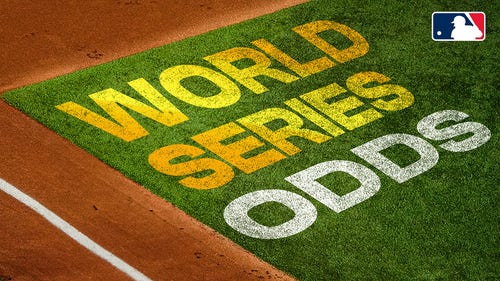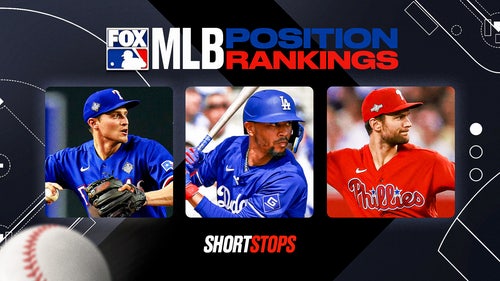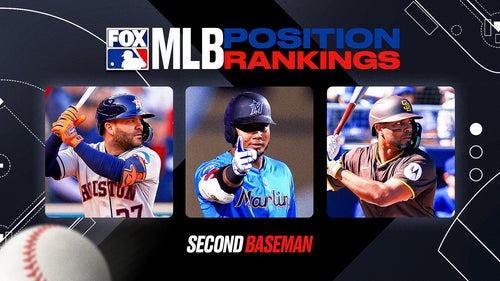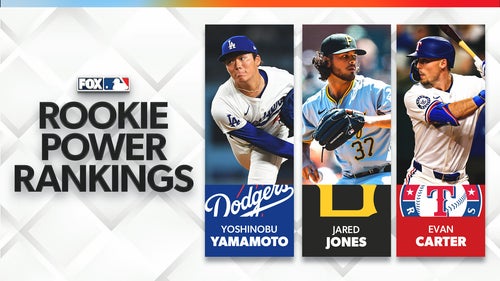
MLB Awards Watch: The Final Ballot
Sep 27, 2016; San Diego, CA, USA; Los Angeles Dodgers shortstop Corey Seager (5) singles during the sixth inning against the San Diego Padres at Petco Park. Mandatory Credit: Jake Roth-USA TODAY Sports
Throughout the 2016 MLB season, we have weighed in with “updates” on each major individual award race in the league. Now, it is time to hand out the hardware.
As baseball fans know full well, the season is a marathon, meaning that the top spot in various races has changed hands on multiple occasions. Still, the best season-long performances are recognized in the end, and we have done our best to incorporate metrics, “traditional” stats and even the (very) occasional narrative.
To the awards we go, beginning with NL Rookie of the Year and moving on from there.
NL Rookie of the Year
Corey Seager
SS, Los Angeles Dodgers
In the end, the NL Rookie of the Year race wasn’t a race at all. Corey Seager operated as the favorite throughout the campaign and he finished in a dominant position with 7.5 fWAR and 6.1 bWAR, cruising to the top based on top-flight offensive production and premium defense at arguably the most important position on the field. In truth, Seager is closer to the the top of the MVP race than he is to anyone else in the NL rookie pool, and the 22-year-old also played in 157 games for good measure. It was a banner year for Seager and he’ll be recognized by what should (hopefully) be a unanimous vote. 2
Kenta Maeda
SP, Los Angeles Dodgers
The number two spot is very much up for debate, but I’m rolling with Seager’s much older teammate. One of the “knocks” on Maeda is that he is 28 years old after a lengthy professional career abroad, but that won’t be a deterrent for me and his performance was crucial for the Dodgers in the wake of Clayton Kershaw’s injury issues. The right-hander finished third in the NL in fWAR (3.3) after submitting a season in which he ate through 175.2 innings with a 3.48 ERA (3.58 FIP) and Maeda was also impressive in striking out more than a batter per inning across 32 starts. Maeda’s highs weren’t nearly as high as some of the position players he is competing with here, but there is something to be said for stability and he brought that to the table all year. 3
Trea Turner
2B/OF, Washington Nationals
I don’t love the precedent of anointing Turner after only 73 games, but he was that good. Aledmys Diaz, Trevor Story, Jon Gray and others deserve consideration here, but Turner was absolutely incredible in limited duty, zooming to the number two spot among position players in both WAR categories. His speed (33 SB) is off the charts, but Turner also defended well while adding a .342/.370/.567 slash line (147 wRC+) and, on a per-AB basis, there is an argument that he was even better than Seager. Watching those two players grow up in the near future should be a lot of fun, but Turner was so good that he couldn’t be ignored. Next: AL Rookie of the Year
Sep 16, 2016; Cleveland, OH, USA; Detroit Tigers starting pitcher Michael Fulmer (32) reacts after being called for a balk during the third inning against the Cleveland Indians at Progressive Field. Mandatory Credit: Ken Blaze-USA TODAY Sports
AL Rookie of the Year
Michael Fulmer
SP, Detroit Tigers
The AL rookie pursuit turned out to be closer than most people thought it would be, but the “incumbent” held on (for dear life) in my view. Fulmer has been the leader in the clubhouse for some time, and there is a reason for that. The right-hander finished among the top 10 pitchers in the AL in bWAR (4.9) while zooming past 3 fWAR, and Fulmer’s 3.06 ERA was good for a top-five mark in the league. The peripherals painted a different picture throughout the year, but Fulmer’s lack of strikeout upside did not come back to bite him in a huge way, and he was able to maintain his year-long numbers despite relative struggles in the final weeks. This isn’t a decisive victory (and we’ll see why in a second), but Fulmer is deserving. 2
Gary Sanchez
C, New York Yankees
What an incredible performance. Gary Sanchez played in only 53 MLB games in 2016, but he did enough to warrant legitimate consideration for AL ROY and that tells you just how impressive he was. New York’s catcher of the future (and present) finished with 20 home runs in only 229 plate appearances, and Sanchez put together a slash line of .299/.376/.657 for good measure. His 171 wRC+ is off the charts and Sanchez was able to accumulate 3.1 fWAR despite his limited role throughout the year. Many people will lean in Sanchez’s direction over that of Fulmer, but I just can’t do it. The case would be different if not for a legitimate candidate in Fulmer, but Sanchez earning second place is noteworthy in and of itself. 3
Tyler Naquin
OF, Cleveland Indians
Naquin went to the plate only 365 times, but that feels like more than enough given Sanchez’s late arrival. It should be noted that Naquin is a distant third in my view, but he is also a solid third given the other options and he was quite good at the plate. In those 365 plate appearances, Naquin bashed 14 home runs and finished with a 135 wRC+ and a slugging percentage above .500, producing at an important rate for a playoff-bound team in Cleveland. The defense wasn’t exactly desirable, but with no other standout options, Naquin’s profile is easily good enough to land in third. Congrats, Tyler. Next: NL Cy Young
Sep 21, 2016; Miami, FL, USA; Washington Nationals starting pitcher Max Scherzer (31) throws a pitch during the first inning against the Miami Marlins at Marlins Park. Mandatory Credit: Steve Mitchell-USA TODAY Sports
NL Cy Young
Max Scherzer
SP, Washington Nationals
The AL Cy Young race was arguably more interesting (we’ll get to that), but the NL offers its own challenges. The best pitcher in the sport, Clayton Kershaw, didn’t crack 150 innings due to injury, and there is the off-field story line of Jose Fernandez’s tragic passing and a movement to give him the Cy Young posthumously. However, Scherzer was the best pitcher overall in my mind, and that is backed up by a league-leading 6.2 bWAR. Scherzer also landed among the top five in the National League in fWAR (5.6) with league-leading numbers in wins (20), WHIP (0.968), innings pitched (228.1) and strikeouts (284). For the record, I absolutely do not care about wins, but the other statistics are highly impressive, and I value workload at a very high level. Kershaw was better on a per-game basis, but Scherzer’s total package is at the top of the heap. 2
Madison Bumgarner
SP, San Francisco Giants
I have a feeling that Bumgarner won’t finish this high, but I love what he brings to the table. The left-hander trailed only Scherzer in innings pitched (226.2) and Bumgarner’s workload was even more impressive considering that he finished with top-five numbers in ERA (2.74) and strikeouts (251 and 10.68 per 9 innings). The advanced numbers don’t love Bumgarner in every way, with bWAR placing him only eighth among NL pitchers, but the combination of workload and effectiveness paired with the warts of other pitchers allows San Francisco’s favorite son to ascend. 3
Noah Syndergaard
SP, New York Mets
This is tough. Kershaw deserves consideration here based on his ridiculous numbers, Fernandez’s actual baseball impact is close to Syndergaard (in addition to everything else) and even players like Johnny Cueto and Kyle Hendricks (who led the league in ERA) will be on Cy Young ballots. I’m taking Thor, though, as he finished in the driver’s seat for NL pitchers in fWAR (6.5) with lights-out numbers around that. Syndergaard consumed only 183.2 innings and that, for me, places him behind the top two. However, his 2.60 ERA stands up with anyone and with a 2.29 FIP and nearly 11 strikeouts per 9 innings, Syndergaard was utterly dominant when he took the ball for the Mets. We can nitpick all day, but I love what he brings. Next: AL Cy Young
Sep 21, 2016; Cleveland, OH, USA; Cleveland Indians starting pitcher Corey Kluber (28) throws a pitch during the first inning against the Kansas City Royals at Progressive Field. Mandatory Credit: Ken Blaze-USA TODAY Sports
AL Cy Young
Corey Kluber
SP, Cleveland Indians
What an absolute mess. No American League starting pitcher finished with an ERA below 3.00 (!) and, with that, there is no obvious winner here. For me, Kluber best combines everything that I’m looking for in a Cy Young candidate but, make no mistake, he isn’t a perfect contender either. The powerful right-hander finished in the top five of both major WAR categories for pitchers while striking out more than a batter per inning. While Justin Verlander can also claim that combination, Kluber exceeds him in FIP, walk rate, home run rate and other factors, and while Kluber pitched fewer innings, he pitched more innings per start than his counterpart in Detroit. Trust me, I don’t like any of the options, but Kluber is the best by the smallest of margins. 2
Rick Porcello
SP, Boston Red Sox
I did not include Porcello among my top three at all this season… until the end. Porcello’s claim to fame is that he led the AL in wins (22) and, well, I don’t care about that at all. However, Porcello did ascend into the top five in both fWAR (5.2) and bWAR (5.0) by the end of the year, and he was impressive in chewing through 223 innings for the Red Sox. Porcello lags behind in strikeout rate (7.63 K/9), but his command was dominant all season long (1.29 BB/9) and there wasn’t anything inherently fluky about his 3.15 ERA. He definitely isn’t my traditional picture of a Cy Young contender, but you can’t argue that Porcello wasn’t wildly effective. 3
Justin Verlander
SP, Detroit Tigers
Verlander led the AL in strikeout percentage (28.1%) while striking out more than 10 batters per 9 innings, and his peripherals were quite encouraging. I’m fairly shocked that Verlander was able to muster this type of performance given recent history, but the powerful right-hander posted a 3.04 ERA (3.48 FIP) while leading the league in WHIP (1.001) and finishing second in innings pitched with 227.2 on the year. That is a very strong combination and Detroit really needed his contributions. Sign me up, with apologies to Chris Sale, Masahiro Tanaka, Aaron Sanchez and Zach Britton. Next: NL MVP
Sep 26, 2016; Pittsburgh, PA, USA; Chicago Cubs third baseman Kris Bryant (17) reacts after hitting a single against the Pittsburgh Pirates during the fourth inning at PNC Park. Mandatory Credit: Charles LeClaire-USA TODAY Sports
NL MVP
Kris Bryant
3B/OF, Chicago Cubs
Kris Bryant did not lead the National League in batting average, on-base percentage, slugging percentage or even wRC+, but he was easily the best player in the league this season. Bryant finished 2016 as the NL leader in fWAR (8.4) and bWAR (7.7) by a comfortable margin, and his .292/.385/.554 slash line was impressive on its own. Throw in the fact, then, that Bryant blasted 39 home runs and basically finished within the top ten of every major hitting category, and his candidacy comes into view. On top of that, Bryant proved to be an above-average defender at two different positions and, for the narrative-driven voters, he was the best player on what was easily the top team in the league. Any questions?2
Corey Seager
SS, Los Angeles Dodgers
It is very weird to see a rookie landing this high on an MVP ballot, but if you can see beyond that, it makes sense. Seager’s overall candidacy depends on how much you value defense and positional impact, but I believe greatly in quality defense at a premium position, and so do many of the more advanced, all-encompassing statistics available. Seager finished behind only Bryant in fWAR (7.5) and comfortable within the top four in bWAR (6.1) with the difference being in how the two sites valued his defense. What I saw was a top-flight glove at shortstop, and with his bat playing quite well (137 wRC+, 26 home runs, .308/.365/.512 slash line), I’m all in on Corey Seager. He’s just not Kris Bryant. 3
Freddie Freeman
1B, Atlanta Braves
We’ll get to this argument on the AL side in a more prominent way, but Freeman’s individual contributions matter a lot more to me than what Atlanta didn’t do in the standings. To be fair, I’m nitpicking between Freeman, Colorado’s Nolan Arenado and players like Daniel Murphy, but Freeman finished within the top three in both fWAR (6.1) and bWAR (6.5) for a reason. He was awesome. Only Murphy had a higher wRC+ than Freeman’s 152, and his .302/.400/.569 slash line jumps off the page. In addition, the first baseman exhibited more power than most thought possible in blasting 34 home runs and, essentially, he was the best hitter in baseball from the beginning of May to the end of the season. Many people will ignore him completely based on a lack of team success, but he was pretty darn valuable to the Braves.
Sep 19, 2016; Arlington, TX, USA; Los Angeles Angels center fielder Mike Trout (27) smiles to the bench after hitting a triple and driving in a run during the sixth inning against the Texas Rangers at Globe Life Park in Arlington. Mandatory Credit: Jerome Miron-USA TODAY Sports
AL MVP
Mike Trout
OF, Los Angeles Angels
Unlike the case in the NL where Freddie Freeman will garner less consideration than he deserves, Trout was easily the best player in the AL. He led the league in bWAR (10.6) and fWAR (9.4) by staggering amounts, and it wasn’t as if those calculations hid behind the veil of defensive uncertainty. Trout sits atop Baseball-Reference’s offensive WAR statistic and FanGraphs wRC+ in measuring his offensive greatness, and Trout led the league in OBP while finishing the top five in both batting average and slugging percentage. Oh, and he led the league in walks and runs scored while generally lighting the world on fire. Defensively, Trout measures as slightly above-average, but he plays a premium position and, this year, he didn’t need the defense to be labeled as the runaway MVP. Mike Trout may not win the MVP award, but if he doesn’t, we’ve all failed.
Mookie Betts
OF, Boston Red Sox
Betts really might win this thing, but he should finish second. If some voters look at the advanced statistical leaderboards and simply ignore Trout because of his team, Betts will be the logical choice as the runner-up in both WAR categories. The young, entertaining outfielder blasted 33 home runs, stole 26 bases, scored 122 runs, drove home 113 runs and played above-average defense, and he did it all for a playoff-bound team in a major media market. That is an impressive combination and, frankly, Betts would be a deserving MVP in most years. Unfortunately for Mookie, Mike Trout exists. 3
Josh Donaldson
3B, Toronto Blue Jays
This is a photo finish between Donaldson and Jose Altuve, with Manny Machado running just slightly behind. In the end, I’m taking the superior defender in Donaldson, but that is personal preference. Donaldson has the edge in fWAR while Altuve leads in bWAR, and if you value speed, Altuve is your guy. In terms of sheer hitting, though, Donaldson has the edge given his lead in OBP, slugging and wRC+ and the defensive difference between the two men is quite sharp. For me, this group lands solidly behind Trout and marginally behind Betts, but give me Toronto’s centerpiece at the hot corner.
More from FanSided
This article originally appeared on











